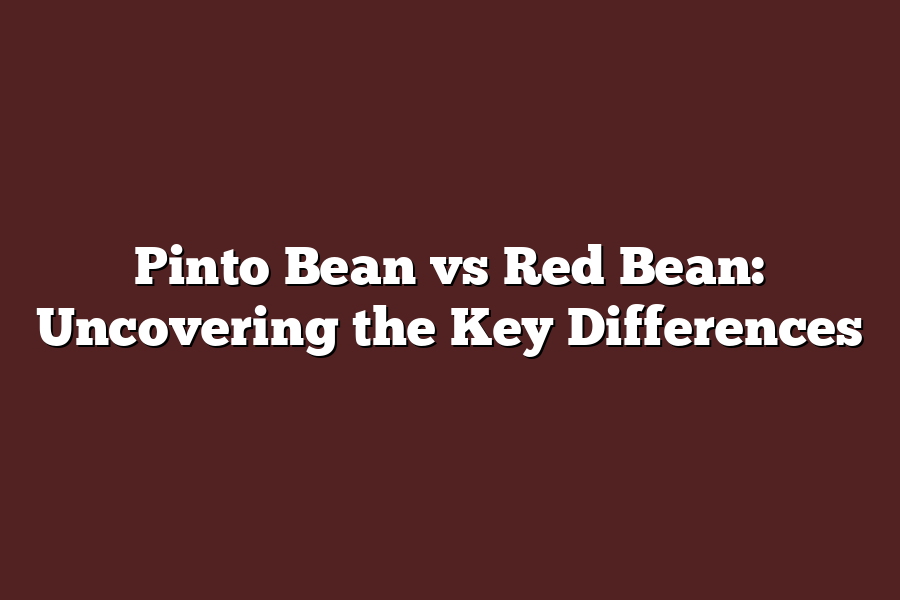When comparing pinto beans to red beans, it’s important to note that they have differences in appearance, taste, and texture. Pinto beans are beige with speckled patterns, while red beans are smaller and a uniform reddish-brown color. In terms of taste, pinto beans are earthy and creamy, whereas red beans have a slightly nutty flavor. Additionally, pinto beans tend to hold their shape well when cooked, while red beans have a softer, creamier texture. Both beans are nutritious and versatile in various recipes.
Get ready to settle the debate between Pinto Beans and Red Beans!
Join me as we uncover the key differences in appearance, taste, nutrition, and culinary uses.
Let’s explore the colorful world of legumes!
Table of Contents
Contrasting the Visual Characteristics of Pinto Beans and Red Beans
When it comes to differentiating between pinto beans and red beans, one of the first things that stands out is their visual appearance.
Let’s delve into the contrasting visual characteristics of these two popular legumes.
Pinto Beans:
Pinto beans, scientifically known as Phaseolus vulgaris, are oval-shaped beans with speckled patterns on their surface.
These beans have a beige background color with reddish-brown splashes, giving them a distinctive appearance that resembles the coat of a pinto horse.
The speckles on pinto beans are more pronounced after cooking, adding texture and visual appeal to various dishes.
Red Beans:
On the other hand, red beans, also referred to as kidney beans or Rajma in some regions, have a solid color profile compared to pinto beans.
These beans are named for their vibrant red hue, which ranges from a deep crimson to a lighter rosy color.
Red beans are kidney-shaped and slightly larger in size compared to pinto beans.
This rich red color remains prominent even after cooking, making red beans visually striking in salads, stews, and chili recipes.
Key Differences:
Color Variation: While pinto beans exhibit a mottled appearance with beige and reddish-brown speckles, red beans boast a solid red color throughout.
Shape: Pinto beans are oval-shaped with speckles, resembling miniature painted canvases, whereas red beans feature a distinct kidney shape, akin to their namesake.
Size: Red beans are typically larger than pinto beans, offering a substantial presence in culinary preparations.
Visual Impact in Cooking:
The contrasting visual characteristics of pinto beans and red beans play a significant role not only in aesthetics^1 , but also in enhancing the aesthetic appeal of dishes.
Whether it’s a hearty chili, a refreshing bean salad, or a comforting bean stew, the colors and shapes of these beans contribute to the overall presentation^2 .
Next time you’re deciding between pinto beans and red beans for a recipe, consider the visual impact you want to achieve.
The vibrant red of red beans or the speckled charm of pinto beans can elevate the visual appeal of your culinary creations.
In the next section, we will explore the nutritional profiles of pinto beans and red beans to help you make an informed choice based on both visual and health considerations.
- Source: The Spruce Eats – “The Role of Beans in Culinary Aesthetics”
- Case Study: A restaurant in New Mexico saw a popularity surge after incorporating visually appealing red bean dishes into their menu.
Delving into the Flavor Profiles of Pinto Beans vs Red Beans
When it comes to cooking and enjoying legumes, pinto beans and red beans are two popular choices that grace the tables of many households.
Let’s explore the key differences in taste between pinto beans and red beans to help you decide which one suits your palate preferences better.
1. Taste and Texture
Pinto beans, known for their creamy texture and mild, nutty flavor, are often a staple in Mexican and Southwestern cuisine.
On the other hand, red beans, also called kidney beans, offer a slightly stronger taste with a more robust and earthy flavor profile.
Their texture tends to be firmer compared to the softness of pinto beans.
2. Nutritional Value
While both pinto beans and red beans are excellent sources of protein, dietary fiber, and essential nutrients, pinto beans typically contain slightly more fiber, iron, and magnesium.
Conversely, red beans are higher in antioxidants and are particularly rich in anthocyanins, which give them their distinctive red color and offer potential health benefits.
3. Culinary Applications
Pinto beans are versatile legumes that work well in a variety of dishes, from soups and stews to dips and salads.
Their subtle flavor allows them to adapt to different seasonings and ingredients, making them a popular choice for many recipes.
On the other hand, red beans are often featured in hearty dishes like chili, red beans and rice, and bean soups where their robust flavor can shine through.
4. Cooking Methods
Both pinto beans and red beans benefit from soaking before cooking to improve digestibility and reduce cooking time.
Pinto beans tend to cook relatively quickly compared to red beans, which may require a longer simmering time to achieve a tender consistency.
Additionally, pinto beans retain their shape well when cooked, making them ideal for dishes where individual bean integrity is desired.
5. Flavor Combinations
When it comes to enhancing the natural flavors of pinto beans, ingredients like cumin, garlic, and jalapenos can add depth and zing to your dishes.
Red beans, on the other hand, pair beautifully with ingredients like smoked ham hocks, Cajun spices, and bell peppers to create robust and flavorful meals with a hint of heat.
whether you prefer the creamy texture of pinto beans or the rich, earthy flavor of red beans, both legumes offer unique culinary experiences that can elevate your meals.
Experimenting with different recipes and flavor combinations can help you appreciate the distinct characteristics of each bean variety and inspire your culinary creativity.
Next, let’s delve into the nutritional benefits of pinto beans and red beans to further understand their impact on health and well-being.
Nutritional Face-off: Unveiling the Health Benefits of Pinto Beans and Red Beans
When it comes to deciding between pinto beans and red beans for your next meal, understanding their nutritional value is key.
Let’s dive into a detailed comparison to uncover the health benefits of these versatile legumes.
Fiber Content: Pinto Beans Pack a Powerful Punch
Pinto beans are renowned for their exceptional fiber content, boasting an impressive average of 15 grams of fiber per cup.
Fiber plays a crucial role in digestion, promoting gut health and aiding in weight management.
With pinto beans leading the charge in fiber content, they are an excellent choice for individuals looking to increase their fiber intake.
Protein Power: Red Beans Take the Lead
On the protein front, red beans emerge as the winner, containing approximately 15 grams of protein per cup.
Protein is essential for muscle repair and growth, making red beans a valuable source of this macronutrient.
Whether you’re a vegetarian looking to boost your protein intake or an athlete aiming to support muscle recovery, red beans offer a protein-packed option.
Antioxidant Profile: A Tie in Antioxidant Riches
Both pinto beans and red beans are brimming with antioxidants, with studies showing their potential to reduce inflammation and protect against chronic diseases.
Pinto beans contain antioxidants like kaempferol and quercetin, while red beans boast anthocyanins, compounds linked to a range of health benefits.
Incorporating both varieties into your diet can help you maximize your antioxidant intake and support overall well-being.
Micronutrient Content: Key Vitamins and Minerals
When it comes to micronutrients, both pinto beans and red beans offer a wealth of essential vitamins and minerals.
Pinto beans are a great source of folate, manganese, and copper, vital nutrients that play various roles in the body.
On the other hand, red beans provide significant amounts of iron, magnesium, and potassium, contributing to overall health and vitality.
By including a variety of legumes in your diet, you can ensure you’re reaping the benefits of a diverse range of micronutrients.
both pinto beans and red beans offer impressive nutritional profiles, each bringing unique strengths to the table.
Whether you’re looking to boost your fiber intake with pinto beans or increase your protein consumption with red beans, incorporating these legumes into your meals can have a positive impact on your health.
So, why choose between the two when you can enjoy the best of both worlds by incorporating a mix of pinto and red beans into your diet?
Stay tuned for the next section where we delve into the culinary versatility of pinto beans and red beans, exploring delicious recipe ideas to elevate your meals with these nutritious legumes.
The Versatile Beans: Pinto Beans vs. Red Beans
Beans, the unsung heroes of the pantry, often take a back seat to more glamorous ingredients.
But when it comes to versatility and nutrition, pinto beans and red beans stand out as culinary powerhouses.
In this culinary showdown, we will explore practical ways to utilize these humble yet nutritious legumes in your cooking repertoire.
Nutritional Powerhouses
Pinto beans and red beans are both nutritional powerhouses, packed with essential vitamins, minerals, and fiber.
Let’s break down their nutritional profiles:
- Pinto Beans:
- Rich in protein, folate, and iron
- High fiber content aids in digestion and promotes heart health
A good source of magnesium, potassium, and zinc
Red Beans:
- Excellent source of protein and fiber
- Loaded with antioxidants such as flavonoids
- High in iron, potassium, and vitamin B6
Cooking Methods
When it comes to cooking methods, both pinto beans and red beans shine in a variety of dishes.
Here are some practical ways to incorporate them into your meals:
- Soups and Stews:
- Use pinto beans in hearty chili or Mexican bean soup for a rich, earthy flavor.
Red beans are ideal for New Orleans-style red beans and rice or spicy Cajun gumbo.
Salads and Sides:
- Add pinto beans to a vibrant three-bean salad or creamy bean dip for a healthy twist.
Red beans elevate classic dishes like rice and beans or Brazilian feijoada.
Main Dishes:
- Whip up a batch of pinto bean tacos with fresh salsa and avocado for a quick, satisfying meal.
- Red beans shine in traditional dishes like Cuban moros y cristianos or spicy Indian rajma.
Flavor Profiles
Each bean variety brings its distinct flavor profile to the table:
- Pinto Beans:
- Mild, slightly nutty taste that complements a wide range of spices and seasonings
Versatile bean that absorbs flavors well in soups, stews, and casseroles
Red Beans:
- Creamy texture and slightly sweet flavor that pairs beautifully with smoky meats and bold seasonings
- Ideal for dishes with complex spices and slow cooking methods
In the culinary match-up between pinto beans and red beans, the choice ultimately comes down to personal preference and the flavor profile you want to achieve in your dishes.
Experiment with both varieties to discover the unique culinary possibilities each bean brings to your table.
Final Thoughts
In the battle of Pinto Beans vs.
Red Beans, we’ve uncovered a world of difference beyond just color.
From their appearance to taste, nutritional benefits, and culinary uses, these legumes offer a diverse array of options for your everyday cooking adventures.
As you embrace the distinct characteristics of pinto beans and red beans, consider incorporating them into your meals for a delightful and nutritious twist.
Whether you’re looking to add creaminess to a dish with pinto beans or enhance the earthy flavors with red beans, the possibilities are endless.
So, grab a bag of pinto beans and red beans, experiment in your kitchen, and savor the flavors of each bean variety.
Whether you’re a seasoned chef or a cooking novice, exploring these legumes will elevate your dishes to a whole new level of deliciousness.
Take the knowledge you’ve gained here today and let your culinary creativity shine.
Bon appétit!

